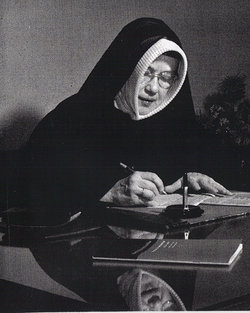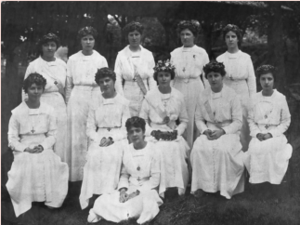Eleanor O'Byrne facts for kids
Quick facts for kids
Mother
Eleanor O'Byrne
|
|
|---|---|

Sister O'Byrne in her office
|
|
| Born | September 12, 1896 |
| Died | October 4, 1987 (aged 91) |
| Occupation | Dean, President |
| Title | Mother |
| Predecessor | Grace Dammann, RSCJ (1930–1945) |
| Successor | Elizabeth McCormack (1965–1974) |
Mother Eleanor O'Byrne (born September 12, 1896, died October 4, 1987) was a leader and activist. She was the fifth president of Manhattanville College. She was a member of the Society of the Sacred Heart.
She worked hard to make education fair for everyone. This included women and African Americans. She also helped move the Manhattanville College campus. It moved from New York City to Purchase, New York. Later, she became president of Universidad del Sagrado Corazón.
Contents
Early Life and Family
Eleanor O'Byrne was born on September 12, 1896. Her parents were Marie and Michael O’Byrne. She grew up in Savannah, Georgia. She had four siblings, but they all passed away young.
Her family believed strongly in religion and helping the community. Her father was a lawyer in Savannah. He was part of many groups like the American Irish Historical Society. He was also involved with the Knights of Columbus. Her mother was very religious too. She helped pay for repairs at the Cathedral of St. John the Baptist.
Eleanor's mother died in 1903. Her father later married Sara Lorene Wren. Sara had also gone to Manhattanville College.
Education and First Jobs
Eleanor O’Byrne first went to the Pape School in Savannah. Then she studied at Manhattanville College. She won the "Prize of Excellence" award when she graduated in 1915.
The next year, she joined the Society of the Sacred Heart. She took her vows on December 8, 1918. After that, she earned her Master’s degree from Fordham University.
Her first job was in 1924. She became the Directress of Studies at Convent of the Sacred Heart, Overbrook. This school is now called Sacred Heart Academy Bryn Mawr. She worked there until 1928.
She then moved to a Sacred Heart school near Washington, D.C. for a year. In 1933, she earned another Bachelor’s degree from Oxford. She then taught history at Manhattanville College. The next year, she became the Dean of Students. She held this role until 1945. She got her second Master’s degree from Oxford in 1936.
Leading Manhattanville College
Mother O’Byrne became president of Manhattanville College in 1945. This happened after the sudden death of the previous president, Mother Grace Damman. Students really liked Mother O'Byrne. She knew almost all of them by their first names.
During her time as president, the school grew a lot. Its value tripled to $19.1 million. Money given by alumni also increased a lot. The number of teachers doubled. Student enrollment grew from 399 to 935 students.
Moving the Campus
One of her biggest achievements was moving the school. City College needed more space after World War II. They asked to take over Manhattanville’s campus in 1949.
Manhattanville College found a new piece of land. It was the estate of Whitelaw Reid in Purchase, New York. They quickly planned and built the new campus. The old campus officially became part of City College in 1951. Manhattanville received $8,808,620 for their old campus.
Student Activism and Chapel
Under Mother O'Byrne's leadership, students became very active. They spoke out about racial equality and poverty. In 1963, she led two professors and six students. They went to Washington D.C. to join the March on Washington for Jobs and Freedom.
In 1962, a new building was finished. It was named the O’Byrne Chapel after her. When asked about the chapel's modern stained glass, she said, "We are living in a contemporary world."
From 1967 to 1970, Mother O'Byrne was president of Universidad del Sagrado Corazón.
Working for Change
Mother O’Byrne worked hard for equality in education and jobs. She was part of many important groups. These included the American Association of University Women and the College Board. She also worked with political leaders like Robert F. Kennedy and Nelson Rockefeller.
She was very proud of her work for the African American community. In 1953, she pushed for scholarships for black students. She was a director of Catholic Scholarships for Negroes Inc. She was also part of the United Negro College Fund. In 1963, she worked with Roy Wilkins of the NAACP.
She received many awards for her efforts. She got honorary degrees from NYU, Fordham University, and Georgetown University. In 1966, France gave her the Award of Palmes Academiques. This was for her contributions to education.
Retirement
Mother O'Byrne announced her retirement in July 1966. Many people were surprised. She was healthy, but ready to move on. Ogden Reid of New York honored her in the Congressional Record. He called her "One of the ablest, most creative and thoughtful leaders of higher education in America."
Even in retirement, she kept working for change. She said, "I won’t be knitting by the fireplace." She continued to serve on Governor Nelson Rockefeller’s Commission. This group focused on education and jobs for women. She retired fully to Kenwood Convent. She passed away there on October 4, 1987, at age 91.



